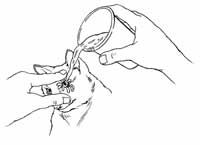Step 1: Remove the cat to fresh air immediately.
Step 2: If the cat is not breathing, feel for heartbeat by placing fingers about one inch behind the cat's elbow and in the center of its chest.
Step 3: If the heart is not beating, proceed to Step 4. If the heart is beating, go to Step 3a to begin to perform artificial respiration.
Step 3a: Turn the cat on its side. Extend the cat's head and neck. Hold the cat's mouth and lips closed and blow firmly into its nostrils. Administer one breath every three to five seconds. Repeat until you feel resistance or see the chest rise.
Step 4: If the heart is not beating, perform cardiopulmonary resuscitation (CPR).
Step 4a: Turn the cat on its side.
Step 4b: Kneel down at the head of the cat.
Step 4c: Grasp the chest so that the breastbone is resting in the palm of your hand, your thumb on one side of the chest and your fingers on the other. Your thumb and fingers should fall in the middle of the chest.
Step 4d: Compress the chest by firmly squeezing your thumb and fingers together. Strive for 100 to 160 compressions per minute.
Step 4e: Alternately (after 30 seconds), hold the cat's mouth and lips closed and blow firmly into its nostrils. Blow for three seconds, take a deep breath, and repeat until you feel resistance or see the chest rise. Repeat this 10 to 20 times per minute.
Step 4f: After one minute, stop. Look at the chest for breathing movement and feel for heartbeat by placing fingers about one inch behind cat's elbow and in the center of its chest.
Step 4g: If the cat's heart is still not beating, continue CPR. If the heart starts beating, but the cat is still not breathing, return to Step 3a to continue artificial respiration.
Step 5: Transport the cat to the veterinarian immediately.
©Publications International, Ltd.
